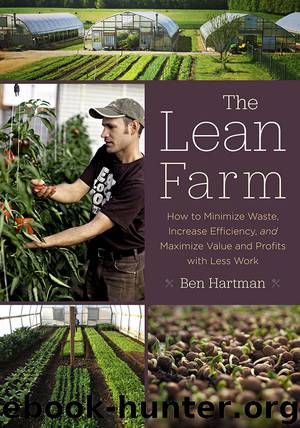The Lean Farm Guide to Growing Vegetables: More In-Depth Lean Techniques for Efficient Organic Production by Ben Hartman

Author:Ben Hartman [Hartman, Ben]
Language: eng
Format: epub
Tags: DIY, farming
ISBN: 9781603586993
Amazon: 1603586997
Publisher: Chelsea Green Publishing
Published: 2017-10-26T22:00:00+00:00
Pete Johnson at Pete’s Greens in northern Vermont has forged new winter markets for his greens and other vegetables. He told me that through storage and winter production, “our smallest week of sales in the winter is now two-thirds of our biggest summer week of sales.” This is an incredible feat in a climate that often provides just two months of frost-free weather. In similar fashion, Steve Lecklider at Lehman’s Orchard saves the winter months for value-adding his leftover fruit and selling value-added products. His winter sales are a significant part of his bottom line.
We appreciate the slower pace of winter—there is something to be said for time off and seasonal rest—but because we also realize the benefits of a more level work pace, we keep the farm going all year, though not in full gear during midwinter. We end our CSA in December but continue delivering to a farmers’ market all winter. In addition, we create a winter projects list. We want to do as much as possible in the winter to prepare for the busier summer. Our list includes tasks like oiling tool handles, sharpening blades, decluttering, and fixing tools. Bed preparation is also on the list. In early winter, when the ground is still dry enough to work, we prep our beds—chisel plow, till, shape, or add compost—in order to jump-start our spring planting.
Load leveling requires both raising low points as well as bringing down high points. For us, this means finding ways to temper our summer pace to reduce overburden. We’ve found that filling time in winter is easy compared to slowing down in summer. With time, we are getting better at scheduling in summer breaks, such as by taking off a few weeks in the middle of the CSA season and keeping summer production in check. The goal is to keep our energy reserves stocked so that our work flows predictably and smoothly any time of year.
Tool 6: Use Metrics to Measure Your Work
Metrics are goalposts to assess progress on waste reduction in your operation. Lean managers use them to motivate workers and steer their operations. The most useful metrics follow these rules:
1. They must be measurable. If you can’t measure a metric, there is no point in having it.
2. They must be attainable. Metrics, if used as goals, should be within reach in a reasonable amount of time. In Chapter 1 I discussed the idea that people are happiest when they experience flow, a state of deep concentration. One of the conditions for a flow task is that its level of difficulty should be somewhat challenging. If the task is too challenging, flow is broken and focus is lost due to frustration. If the task is not challenging enough, boredom breaks flow. In the same way, attainable metrics keep staff and farmers motivated (and happier) because they provide an attainable challenge and focus.
3. They must be meaningful. Metrics let farmers steer their farms in the direction of their visions. Metrics should be aligned with long-term vision.
Download
This site does not store any files on its server. We only index and link to content provided by other sites. Please contact the content providers to delete copyright contents if any and email us, we'll remove relevant links or contents immediately.
| Automotive | Engineering |
| Transportation |
Whiskies Galore by Ian Buxton(40335)
Introduction to Aircraft Design (Cambridge Aerospace Series) by John P. Fielding(32339)
Small Unmanned Fixed-wing Aircraft Design by Andrew J. Keane Andras Sobester James P. Scanlan & András Sóbester & James P. Scanlan(32141)
Craft Beer for the Homebrewer by Michael Agnew(17448)
Turbulence by E. J. Noyes(7041)
The Complete Stick Figure Physics Tutorials by Allen Sarah(6641)
Kaplan MCAT General Chemistry Review by Kaplan(6054)
The Thirst by Nesbo Jo(5786)
Bad Blood by John Carreyrou(5770)
Learning SQL by Alan Beaulieu(5412)
Weapons of Math Destruction by Cathy O'Neil(5038)
Man-made Catastrophes and Risk Information Concealment by Dmitry Chernov & Didier Sornette(4738)
iGen by Jean M. Twenge(4702)
Digital Minimalism by Cal Newport;(4545)
Life 3.0: Being Human in the Age of Artificial Intelligence by Tegmark Max(4509)
Audition by Ryu Murakami(4099)
1,001 ASVAB Practice Questions For Dummies by Powers Rod(4040)
Electronic Devices & Circuits by Jacob Millman & Christos C. Halkias(4029)
Pale Blue Dot by Carl Sagan(4004)
